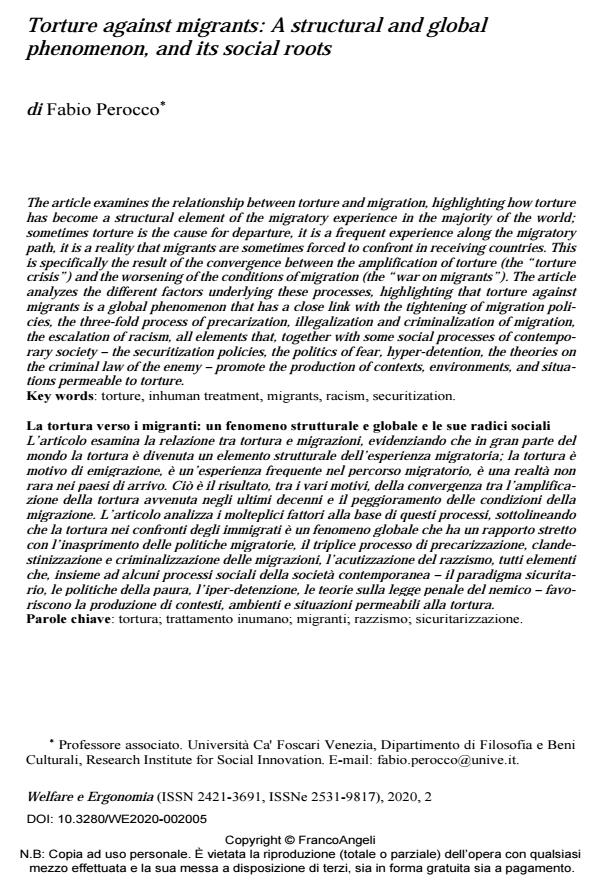Torture against migrants: A structural and global phenomenon, and its social roots
Titolo Rivista WELFARE E ERGONOMIA
Autori/Curatori Fabio Perocco
Anno di pubblicazione 2021 Fascicolo 2020/2
Lingua Inglese Numero pagine 15 P. 50-64 Dimensione file 211 KB
DOI 10.3280/WE2020-002005
Il DOI è il codice a barre della proprietà intellettuale: per saperne di più
clicca qui
Qui sotto puoi vedere in anteprima la prima pagina di questo articolo.
Se questo articolo ti interessa, lo puoi acquistare (e scaricare in formato pdf) seguendo le facili indicazioni per acquistare il download credit. Acquista Download Credits per scaricare questo Articolo in formato PDF

FrancoAngeli è membro della Publishers International Linking Association, Inc (PILA)associazione indipendente e non profit per facilitare (attraverso i servizi tecnologici implementati da CrossRef.org) l’accesso degli studiosi ai contenuti digitali nelle pubblicazioni professionali e scientifiche
The article examines the relationship between torture and migration, highlighting how torture has become a structural element of the migratory experience in the majority of the world; sometimes torture is the cause for departure, it is a frequent experience along the migratory path, it is a reality that migrants are sometimes forced to confront in receiving countries. This is specifically the result of the convergence between the amplification of torture (the "torture crisis") and the worsening of the conditions of migration (the "war on migrants"). The article analyzes the different factors underlying these processes, highlighting that torture against migrants is a global phenomenon that has a close link with the tightening of migration policies, the three-fold process of precarization, illegalization and criminalization of migration, the escalation of racism, all elements that, together with some social processes of contemporary society - the securitization policies, the politics of fear, hyper-detention, the theories on the criminal law of the enemy - promote the production of contexts, environments, and situations permeable to torture.
L’articolo esamina la relazione tra tortura e migrazioni, evidenziando che in gran parte del mondo la tortura è divenuta un elemento strutturale dell’esperienza migratoria; la tortura è motivo di emigrazione, è un’esperienza frequente nel percorso migratorio, è una realtà non rara nei paesi di arrivo. Ciò è il risultato, tra i vari motivi, della convergenza tra l’amplificazione della tortura avvenuta negli ultimi decenni e il peggioramento delle condizioni della migrazione. L’articolo analizza i molteplici fattori alla base di questi processi, sottolineando che la tortura nei confronti degli immigrati è un fenomeno globale che ha un rapporto stretto con l’inasprimento delle politiche migratorie, il triplice processo di precarizzazione, clandestinizzazione e criminalizzazione delle migrazioni, l’acutizzazione del razzismo, tutti elementi che, insieme ad alcuni processi sociali della società contemporanea - il paradigma sicuritario, le politiche della paura, l’iper-detenzione, le teorie sulla legge penale del nemico - favoriscono la produzione di contesti, ambienti e situazioni permeabili alla tortura.
Parole chiave:Tortura; trattamento inumano; migranti; razzismo; sicuritarizzazione.
Fabio Perocco, Torture against migrants: A structural and global phenomenon, and its social roots in "WELFARE E ERGONOMIA" 2/2020, pp 50-64, DOI: 10.3280/WE2020-002005